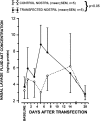Gene therapy for alpha-1 antitrypsin deficiency
- PMID: 21498872
- PMCID: PMC3095063
- DOI: 10.1093/hmg/ddr156
Gene therapy for alpha-1 antitrypsin deficiency
Abstract
Alpha-1 antitrypsin (AAT) deficiency is a common single-gene disorder among Northern Europeans and North Americans. The carrier frequency for the common missense mutation (Z-AAT) ranges from 4% in the US to nearly 25% in the Republic of Ireland. Severe AAT deficiency (plasma levels below 11 μm) is most commonly associated with an adult-onset lung disease, with pan-acinar emphysema and airway inflammation, which is thought to be primarily owing to the loss of function of AAT in neutralizing neutrophil elastase and other pro-inflammatory enzymes. In 5-10% of patients, severe liver disease may develop. This may occur at any time from infancy to adulthood, and is thought to be owing to toxicity from the Z-AAT mutant protein that folds poorly and forms insoluble polymers within the hepatocyte, which is the primary site for AAT production. Thus, gene therapy for AAT lung disease is conceived of as augmentation of serum levels (a prolonged form of protein replacement, which is currently in use), while gene therapy for liver disease presents the problem of also having to downregulate the production of Z-AAT protein. Over the years, numerous strategies have been employed for the gene therapy of both AAT-deficient lung disease and liver disease. These will be reviewed with an emphasis on modalities that have reached clinical trials recently.
Figures



References
-
- Song H.K., Lee K.N., Kwon K.S., Yu M.H., Suh S.W. Crystal structure of an uncleaved alpha 1-antitrypsin reveals the conformation of its inhibitory reactive loop. FEBS Lett. 1995;377:150–154. - PubMed
-
- Lomas D.A. Loop-sheet polymerization: the structural basis of Z alpha 1- antitrypsin accumulation in the liver. Clin. Sci. (Colch) 1994;86:489–495. - PubMed
-
- Huntington J.A., Pannu N.S., Hazes B., Read R.J., Lomas D.A., Carrell R.W. A 2.6 Ǻ structure of a serpin polymer and implications for conformational disease. J. Mol. Biol. 1999;293:449–455. - PubMed
-
- Sharp H.L., Bridges R.A., Krivit W., Freier E.F. Cirrhosis associated with alpha-1-antitrypsin deficiency: a previously unrecognized inherited disorder. J. Lab. Clin. Med. 1969;73:934–939. - PubMed
-
- Sveger T. Liver disease in alpha1-antitrypsin deficiency detected by screening of 200,000 infants. N. Engl. J. Med. 1976;294:1316–1321. - PubMed
Publication types
MeSH terms
Grants and funding
LinkOut - more resources
Full Text Sources
Other Literature Sources
Medical
Research Materials
Miscellaneous

